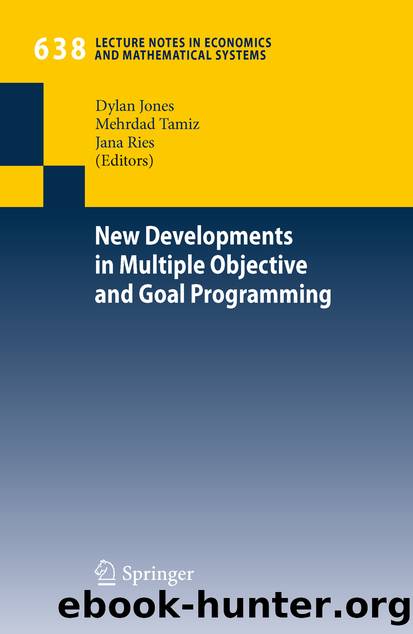New Developments in Multiple Objective and Goal Programming by Dylan Jones Jana Ries & Mehrdad Tamiz

Author:Dylan Jones, Jana Ries & Mehrdad Tamiz
Language: eng
Format: epub
Publisher: Springer Berlin Heidelberg, Berlin, Heidelberg
2 Objective Reduction by Aggregating Objectives
In a multiobjective setting, k objective functions f i : X â Z (1 ⤠i ⤠k) that map a solution x â X from the decision space X to its objective vector f(x) = (f 1(x), â¦, f k (x)) have to be optimized simultaneously. We consider, without loss of generality, minimization problems only. The goal is to compute or approximate the set of Pareto optimal solutions with respect to a given dominance structure. Here, we assume that the underlying dominance structure is given by the weak Pareto dominance relation , i.e., a solution x â X is at least as good as or weakly dominating a solution y â X () with respect to a set â±â² of objective functions if . We call two solutions incomparable if neither weakly dominates the other one, comparable if one dominates the other, and indifferent if they are mutually dominating each other. A solution x â â X is called Pareto optimal if for any other solution x â X, x â is either weakly dominating x or is incomparable to x with respect to the set of all objectives. The set of all Pareto optimal solutions is called Pareto(-optimal) set, for which an approximation is sought.
Although the entire set of objectives is of interest, the reduction to a smaller set might be necessary in practice, e.g., in terms of decision making where a small set of objectives can be easier taken into account than many objectives or in terms of search when the computation time highly depends on the number of objectives.1 In this case of objective reduction, the question arises how the weak dominance relation changes if objectives are omitted. This question has been already answered in detail in previous studies (Brockhoff and Zitzler 2007b, 2009; Brockhoff et al. 2007): the only possible changes if objectives are omitted are that comparable solutions can become indifferent and incomparable solutions can become comparable or indifferent. In other words, only new comparabilities can be introduced by omitting objectives.
Example 1.
The left-hand side of Fig. 1 shows the parallel coordinates plot of three solutions a (solid line), b (dashed) and c (dotted) that are pairwisely incomparable. If the first objective f 1 is omitted, all three solutions remain mutually incomparable, i.e., the problem structure is preserved. If we, however, omit any two objectives, the dominance relation between the three solutions will change, e.g., if we omit in addition to f 1 also f 2, the solution a becomes weakly dominated by solution c considering minimization of the objectives, cf. the middle plot of Fig. 1.
Download
This site does not store any files on its server. We only index and link to content provided by other sites. Please contact the content providers to delete copyright contents if any and email us, we'll remove relevant links or contents immediately.
Zero to IPO: Over $1 Trillion of Actionable Advice from the World's Most Successful Entrepreneurs by Frederic Kerrest(4058)
Machine Learning at Scale with H2O by Gregory Keys | David Whiting(3635)
Harry Potter and the Goblet Of Fire by J.K. Rowling(3612)
Never by Ken Follett(3531)
Ogilvy on Advertising by David Ogilvy(3336)
Shadow of Night by Deborah Harkness(3177)
The Man Who Died Twice by Richard Osman(2810)
Book of Life by Deborah Harkness(2720)
My Brilliant Friend by Elena Ferrante(2703)
How Proust Can Change Your Life by Alain De Botton(2615)
0041152001443424520 .pdf by Unknown(2599)
Will by Will Smith(2581)
The Tipping Point by Malcolm Gladwell(2561)
How to Pay Zero Taxes, 2018 by Jeff A. Schnepper(2500)
Purple Hibiscus by Chimamanda Ngozi Adichie(2487)
Hooked: A Dark, Contemporary Romance (Never After Series) by Emily McIntire(2423)
Rationality by Steven Pinker(2150)
Borders by unknow(2119)
Daughter of Smoke and Bone by Laini Taylor(2082)
